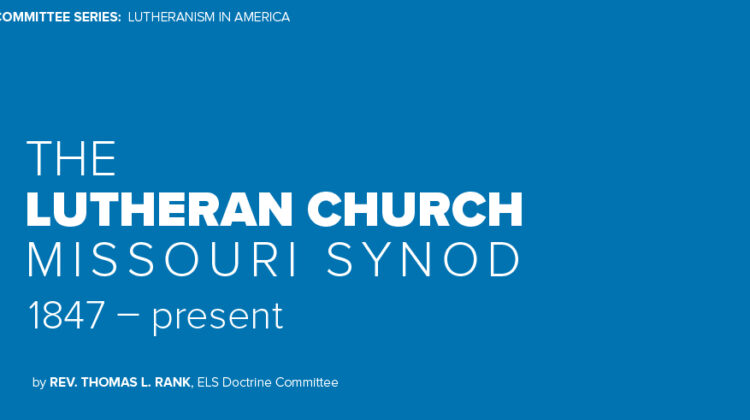
In 1847, The German Evangelical Lutheran Synod of Missouri, Ohio and Other States was organized. This synod was re-named to what we know it as today, the Lutheran Church—Missouri Synod, in 1947 (LCMS). In 1853, when our own predecessor synod formed, the “old” Norwegian Synod, Norwegian pastors found confessional agreement with the Missouri Synod. So began close ties between the two synods, exhibited in declaring fellowship with each other in 1857 and also in their membership in the Synodical Conference (1872). (The ELS would join the Synodical Conference again after our reorganization in 1918.)
One of the most significant Lutherans of the late 19th century in America, Pastor C.F.W. Walther, served the Missouri Synod as synod president and seminary president. Under Walther’s confessionally sound leadership, the synod was blessed with a firm commitment to the truth of Scripture as confessed and taught in the Lutheran Confessions. This commitment echoed what the Norwegian Synod pastors had been taught in Norway and brought with them to the new world.
In the 1870s, a significant theological discussion arose in the Missouri Synod and the Norwegian Synod. The doctrine of election became the focal point for heated debate. The theological struggle that ensued hit the Norwegian Synod particularly hard, bringing about its decision to leave the Synodical Conference in order not to bring division into that body, too.
Over the next decades and into the 20th century, the Missouri Synod grew significantly, becoming one of the largest Lutheran church bodies in America. After World War II, the rate of growth increased, going from 1.6 million in 1950 to nearly 2.8 million in 1970. Current membership is 1.8 million.
In the 1930s and 1940s, theological developments began to weaken the scriptural and confessional commitment of the LCMS. Discussion between the LCMS and the American Lutheran Church (ALC) were showing a drift toward doctrinal compromise (unionism) on major issues of the Christian faith, including the inspiration of Scripture, objective justification, and election. Concerns over these trends were discussed regularly in the Synodical Conference in the late 1940s and early 1950s. The ELS was particularly concerned with the LCMS’s desire to seek fellowship with church bodies which promoted and allowed the very false teachings (specifically on election) that had led to the ELS leaving the merger of other Norwegian church bodies in 1917, a wound which had scarcely healed.
The ensuing discussions within the Synodical Conference led the ELS and the Wisconsin Synod to see growing and dangerous doctrinal weaknesses in the LCMS. In an address at the centennial convention of the ELS in 1953, the delegates heard this: “If Missouri decides to fellowship with the ALC, she will not be transgressing an isolated commandment occurring here and there in the Bible—although that would be serious enough, she will be jeopardizing that which is the very source of her strength, she will be denying her faith” (Robert Preus, “Our Mission as a Remnant,” quoted in A City Set on a Hill, 182). In 1955, the ELS suspended fellowship with the LCMS after nearly a century, a difficult but necessary decision. The WELS would follow suit in 1961.
In less than two decades, the LCMS would face perhaps its most significant challenge. In 1974, the decision was made to remove the current president of Concordia Seminary, St. Louis. The resulting “walk-out” in support of the seminary president eventually resulted in a new church body, with 100,000 members leaving along with many pastors and professors. The new church body, the Association of Evangelical Lutheran Churches (AELC), would later merge with other church bodies to form the current ELCA (1988).
The issues which led to our suspension of fellowship with the LCMS in 1955 have not been resolved in these subsequent seven decades. However, there are welcome signs of renewed commitment to Scripture and the Lutheran confessions within the church body. There is a common confessional “language” between some in the LCMS and the ELS. Yet it cannot be denied that within the LCMS of the 2020s, there remains a doctrinal divide. There are those who are very close to us in doctrine and practice, yet there are those who are far closer to the false teachings (e.g. women pastors, open communion) of the ELCA.
As we look over the landscape of American Lutheranism, the LCMS and our own ELS, it is good to heed the words which close our synod history book of 1968, A City Set on a Hill: “Truth, as a body of doctrine, can indeed be set before a people by a preceding generation, but each succeeding generation must, through the Holy Spirit, make this truth its own as a part of its very faith and life before it can actually be said to possess it….Each succeeding generation must start all over again. In this way alone is a synod spared from offensive pride, dead orthodoxy, and liberalism. In this way alone is a new generation enabled to sing: ‘God’s Word is our great heritage’” (265).
Rev. Thomas L. Rank